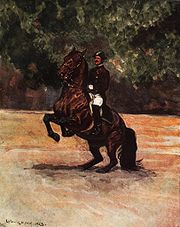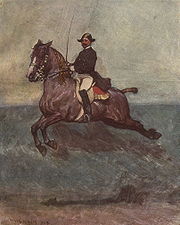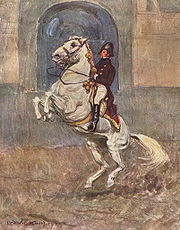
Airs above the ground
Encyclopedia



Classical dressage
Classical dressage evolved from cavalry movements and training for the battlefield, and has since developed into the competitive dressage seen today...
movements in which the horse leaves the ground. They include the capriole, the courbette, the mezair, the croupade and the levade. None are typically seen in modern competitive dressage. They are performed by horses of various riding academies
Riding academy
A riding academy or riding center is a school for instruction in equestrianism, or for hiring of horses for pleasure riding.At the time of the Napoleonic Wars large buildings were constructed for them, like Moscow Manege, Mikhailovsky and Konnogvardeisky maneges in St Petersburg....
such as the Spanish Riding School
Spanish Riding School
The Spanish Riding School of Vienna, Austria, is a traditional riding school for Lipizzan horses, which perform in the Winter Riding School in the Hofburg...
in Vienna
Vienna
Vienna is the capital and largest city of the Republic of Austria and one of the nine states of Austria. Vienna is Austria's primary city, with a population of about 1.723 million , and is by far the largest city in Austria, as well as its cultural, economic, and political centre...
and the Cadre Noir
Cadre Noir
The Cadre Noir is an equestrian display team based in the city of Saumur in western France. The troop was founded in 1828, and gets its name from the black uniforms that are still used today...
in Saumur
Saumur
Saumur is a commune in the Maine-et-Loire department in western France.The historic town is located between the Loire and Thouet rivers, and is surrounded by the vineyards of Saumur itself, Chinon, Bourgueil, Coteaux du Layon, etc...
, and may be seen in other dressage performances. The levade and courbette are a particular feature of the Doma Menorquina
Doma Menorquina
Doma menorquina is the traditional style of riding of the island of Menorca. It is closely associated with the Menorquín horse.Doma menorquina is based on classical dressage and resembles a combination of Alta Escuela and Doma vaquera disciplines. Usually, stallions 3–4 years old are trained...
, the riding tradition of the island of Menorca. Horses such as the Andalusian
Andalusian horse
The Andalusian, also known as the Pure Spanish Horse or PRE , is a horse breed developed in the Iberian Peninsula. Its ancestors have been present on the Iberian Peninsula for thousands of years. The Andalusian has been recognized as an individual breed since the 15th century, and its conformation...
, Lusitano
Lusitano
The Lusitano is a Portuguese horse breed, closely related to the Spanish Andalusian horse. Both are sometimes called Iberian horses, as the breeds both developed on the Iberian peninsula, and until the 1960s they were considered one breed, under the Andalusian name...
, Lipizzan
Lipizzan
The Lipizzan or Lipizzaner , is a breed of horse closely associated with the Spanish Riding School of Vienna, Austria, where the finest representatives demonstrate the haute école or "high school" movements of classical dressage, including the highly controlled, stylized jumps and other movements...
and Menorquín are the breeds most often trained to perform the airs today, in part due to their powerfully conformed hindquarters, which allow them the strength to perform these difficult movements. There were originally seven airs, many of which were used to build into the movements performed today.
There is a popular conception that these movements were originally taught to horses for military purposes, and indeed both the Spanish Riding School and the Cadre Noir are military foundations. However, while agility was necessary on the battlefield, most of the airs as performed today would have exposed the vulnerable underbelly of the horse to the weapons of foot soldiers. It is therefore more likely that the airs were exercises to develop the military horse and rider, rather than to be employed in combat.
Horses are usually taught each air on the long rein without a rider, which is less strenuous for the animal. However, each movement is meant to eventually be performed under a rider.
The pesade and the levade
The pesade and levade are the first airs taught to the High School horse, and it is from these that all other airs are taught. In the pesade, the horse raises its forehand off the ground and tucks the forelegs evenly, carrying all weight on the hindquarters, to form a 45 degree angle with the ground.The levade was first taught at the beginning of the 20th century, asking the horse to hold a position approximately 30-35 degrees from the ground. Unlike the pesade, which is more of a test of balance, the decreased angle makes the levade an extremely strenuous position to hold, and requires a greater effort from the horse. Therefore, many horses are not capable of a good-quality levade. The levade is also a transition movement between work on the ground and the airs above the ground. Neither of these movements are equivalent to rearing
Rear (horse)
Rearing occurs when a horse or other equid "stands up" on its hind legs with the forelegs off the ground. Rearing may be linked to fright, aggression, excitement, disobedience, or pain. It is not uncommon to see stallions rearing in the wild when they fight, while striking at their opponent with...
, as they require precise control, excellent balance, and a great deal of strength, and are the product of correct training, rather than resistance from the horse.
The horse is asked to enter the pesade or levade from the piaffe
Piaffe
The piaffe[p] is a dressage movement where the horse is in a highly collected and cadenced trot, in place or nearly in place. The center of gravity of the horse should be more towards the hind end, with the hindquarters slightly lowered and great bending of the joints in the hind legs...
, which asks the horse to increasingly engage its hindquarters, lowering them toward the ground and bringing the hind legs more toward its center of gravity. This gives the viewer the impression that the horse appears to sink down in back and rise in front. The position is held for a number of seconds, and then the horse quietly puts the forelegs back on the ground and proceeds at the walk, or stands at the halt. The levade is considered to be pinnacle of collection
Collection (horse)
Collection is when a horse carries more weight on his hindlegs than his front legs. The horse draws the body in upon itself so that it becomes like a giant spring whose stored energy can be reclaimed for fighting or running from a predator...
, as the horse carries all weight on the back legs, and has an extreme tucking of the hindquarters and coiling of the loins.

